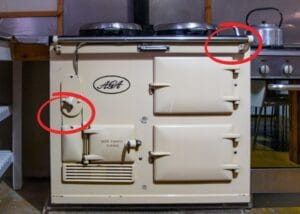We all know that ovens have been an integral part of American kitchens since the 20s. But only a few know that those heavy and large ovens we saw back in the day are much more than just old kitchen appliances; they’re on many collectors’ wishlists!
So, if you’ve been planning to get rid of your vintage oven, stop now – it could actually be worth way more than you’d thought. In this guide, I will walk you through everything you need to know about vintage ovens, from identifying and valuing to spotting rare models!
A Brief History of Ovens
Ovens have been around since the early 20th century, but from the 1920s through the 1960s, companies built them to last forever; you’ll see cast iron, real porcelain enamel, and unique engineering.
After the ’60s, ovens were made more compact and lighter using cheaper and less sturdy materials, like aluminium and fiberglass. Many of those durable pre-1960s ovens are still working in many houses.
These vintage ovens had features and mechanisms that are almost extinct now, like those Chambers stoves that kept cooking even after you turned off the gas. Such models are nowhere to be seen today, making them a hot collectible!
Spotting & Dating a Vintage Oven (5 Key Signs)
Ovens have changed drastically since the 1920s in terms of construction, materials, designs, and features. If you are to spot or date a vintage oven, you must know how to assess these features.
I’ve curated a detailed breakdown of key features that’ll tell whether or not you’re looking at an old piece:
1. Types of Vintage Ovens
Ovens nowadays are quite compact and portable, but when we talk about vintage ovens, there is a lot more to them. Here’s what you’re likely to encounter and how to tell them apart.
Standalone Ranges vs. Built-in Ovens
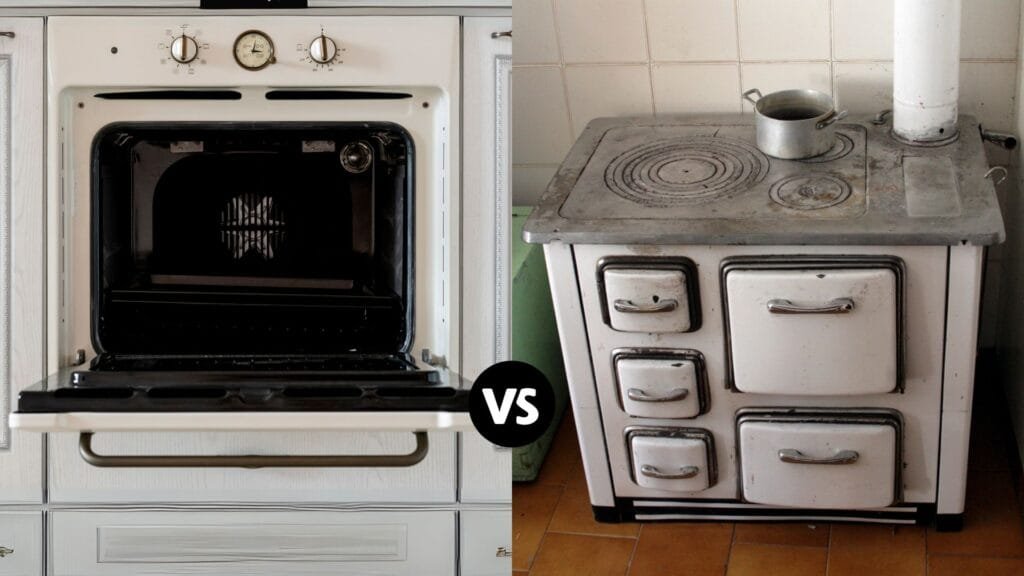
Depending on how the oven is designed to work and placed, there are two basic types to identify:
- Standalone Ovens: Just like the name, these are standalone, complete cooking setups with stovetop, oven, and extras like broilers or warming drawers. These were popular from the early 1900s through the 1950s, with Chambers and O’Keefe & Merritt models being most sought-after!
- Built-in Wall Ovens: These are just the oven part, designed to fit into cabinetry in the wall. These came out in the 1950s, but only became popular when kitchens got more streamlined in the mid-century era. Early versions often had distinctive chrome frames or colorful enamel fronts.
Gas, Electric, and Wood-Burning Models
The source of heating in ovens changed with time, giving us three main types of ovens based on fuel. Here’s how you can identify each:
- Wood-Burning Stoves/Ovens: Popular from the late 1800s to the early 1900s, these have massive cast-iron bodies with ornate details, multiple burner spots on top, and built-in oven compartments. Many had water reservoirs attached. You’ll also see firebox doors, ash collection pans, and chimney connections.
- Gas Models: Early gas ovens were simple, with exposed burners, simple pilot lights, and basic controls. By the 1920s through 1940s, makers added sophisticated temperature controls and built-in broilers. Look for the gas hookups and burner layouts to identify these.
- Electric Versions: Electric ovens showed up around 1900, but early models were slow and inefficient compared to gas. You will find heavy electrical connections and heating coils in these. The 1950s and 60s models took off thanks to their precise heat controls and self-cleaning options.
2. Materials
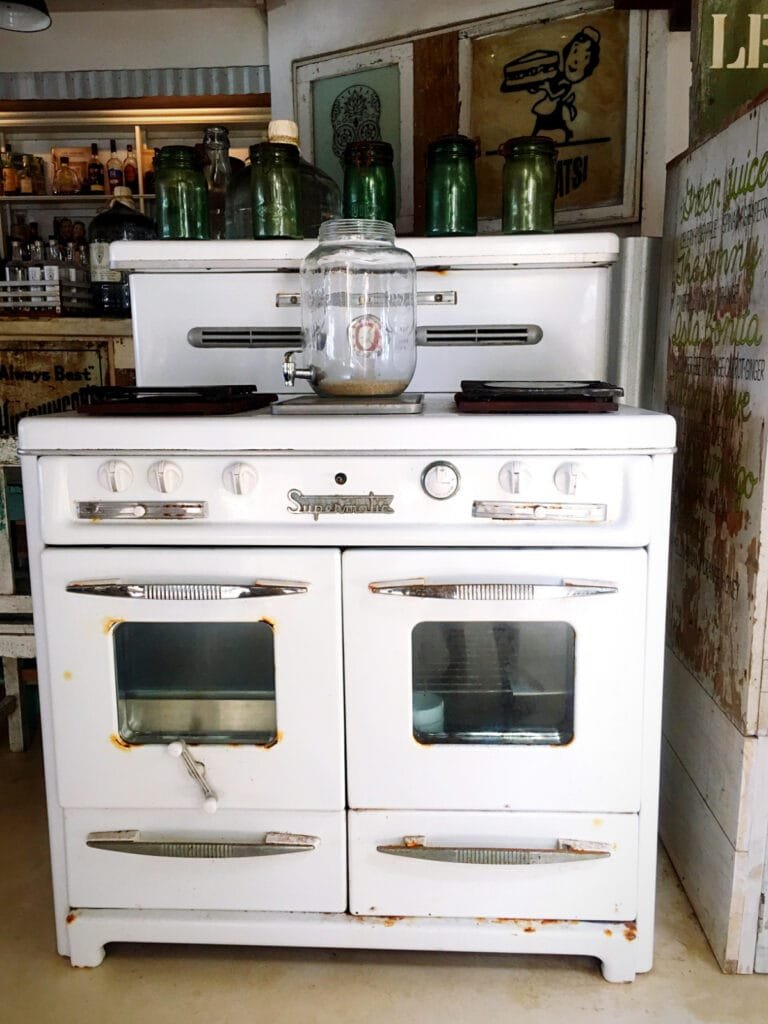
The materials used to make vintage ovens changed dramatically over the decades. Once you understand this evolution, you can date an oven just by knowing what it’s made of.
- Cast Iron (1900-1920s): This was a common material for ovens from the late 1800s through the mid-1900s. You’ll find it in those heavy wood-burning stoves in bodies, doors, and structures, along with hand-forged iron handles and latches. It’s also used as the guts of gas and electric ovens.
- Steel (1920s Onwards): Being lighter than cast iron, steel became a more preferred material for the whole construction (body) as well as the lining of oven cavities where the heat does its work.
- Porcelain Enamel (1920s-1940s): Starting in the early 1900s, manufacturers began coating steel or cast iron oven bodies with this glass-like finish. It was tough, easy to clean, and came in amazing colors, like the bright hues from the 1930s through 1960s. But it chips easily, making older pieces easy to spot.
- Chrome Plating (1930s-1960s): From the 1930s through 1960s, chrome was everywhere – handles, trim, control panels. It gave ovens that sleek, mirror-like finish typical of Art Deco and Mid-Century eras.
- Aluminium: Starting from the early 1920s, makers also began using aluminium for internal components and lightweight parts of the oven.
- Bakelite (1920s-1950s): This early plastic was mostly used for knobs and handles. It became popular since it could handle heat and was easy to mold into shapes. You can spot it by its hard, slightly shiny feel and colors ranging from black and brown to swirled patterns.
- Asbestos (Pre-1970s): Ovens made before the 1970s often used asbestos for insulation because it handled heat so well. If you’re dealing with an older oven, get it checked by a professional before you start taking anything apart.
- Fiberglass & Tempered Glass (Post-1960s): You’ll see these materials in retro versions, in which oven doors and viewing windows were quite prominent.
3. Brands & Makers Marks
Finding out who made your oven is crucial for dating it and determining its real value. This isn’t that tricky, since most vintage ovens featured specific markings, like brand names, logos, location, and model/line name on them.
These marks can be stamped metal tags, data plates, stickers, or cast markings (on cast irons), and you can find them on/at:
- Front areas, like the control panel, oven door front, or backsplash area.
- Sides and Back
- Inside the oven door or storage drawers
- Bottom or under the lid (On Dutch ovens and camp ovens)
As I said above, knowing the maker of a vintage oven can make a significant impact on its value, as models from renowned brands are generally more desirable. Here are some important names to look for:
- Chambers (1912-1988): Chambers is popular worldwide for their super-thick insulation and “Fireless Cooker” technology. Look for “Thermodome” or “Thermowell” features. These ovens are heavy and sturdy, especially the “C” and “Imperial” models.
- O’Keefe & Merritt (Early 1900s-1980s): K-M became a hit after introducing features like “Grillevator” broiler that slides out and “Vanishing Shelf” that pulls out from under burners! You can spot their ovens by the “K-M” logo and bright enamel colors.
- Magic Chef (1929 onward, company from 1881): This company made ovens known for even baking and striking designs. Their Art Deco and streamlined models from the 1930s-1950s are easy to spot thanks to their eye-catching colors.
- Estate Stove Co. (1884 onward): Estate is a mid-range brand, later acquired by Whirlpool, that made all kinds of stoves – wood, coal, and gas. Their vintage ranges were built tough and varied quite a bit depending on their manufacturing year.
4. Era-Specific Design Details
The design of ovens is much more than just their shapes; it’s also about the craftsmanship, colors, and construction. And these features transformed with time, with the major movements, like Victorian and Art Deco, leaving their significant signs.
Below are explained the key era-specific design details that will help you date old ovens by their design and aesthetics.
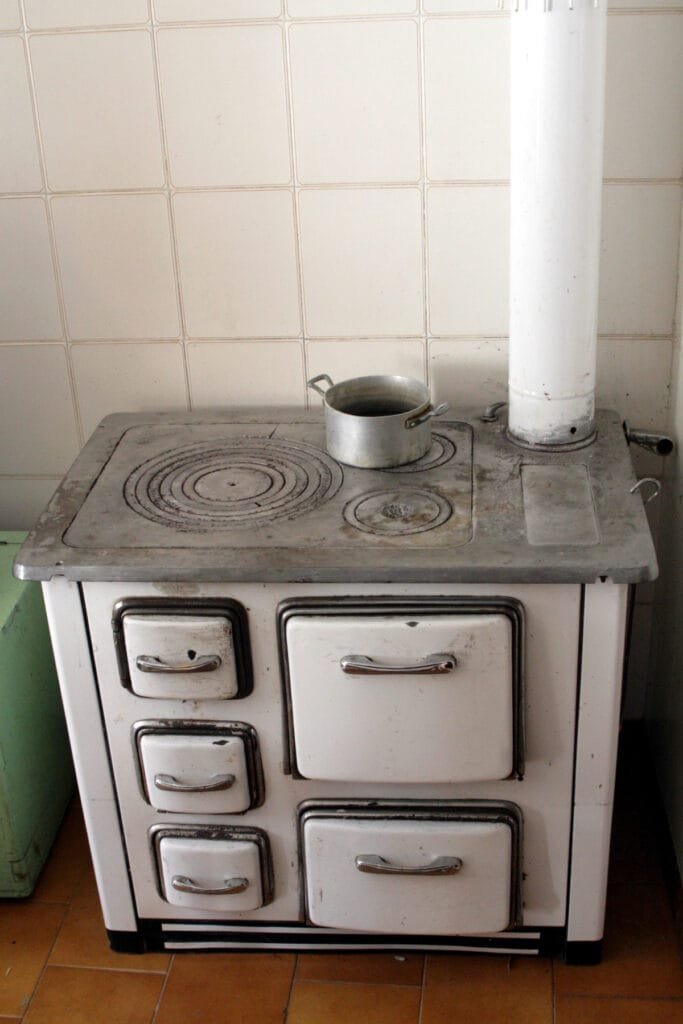
Late 1800s – Early 1900s (Victorian Era):
Ovens from this era feature everything elaborate and over the top, such as:
- Elaborate cast-iron scrollwork and decorative elements
- Shiny nickel plating for trim and accents
- Basic drop-down or side-swing doors with small windows
- Ornate cast iron handles, often with wooden touches
- Tall, decorative legs resembling furniture styles
- Large, elaborate backsplashes with warming shelves or early timers
1920s – 1930s (Art Deco Period):
Art Deco ovens became cleaner and more geometric with bold color statements. You can spot models from this era by the following features:
- Clean geometric shapes and streamlined designs
- Bold colors: greens, blues, yellows in glossy porcelain enamel
- Chrome trim and accents throughout
- Heavier, more substantial doors
- Streamlined Bakelite or geometric chrome handles
- Shorter, chunkier legs or solid plinth-style bases
- Less ornate backsplashes with hidden storage or timer compartments
1940s – 1950s (Mid-Century Modern):
Ovens from this period display modern design features, like rounded corners, efficient layouts, and those famous pastel colors (pink, turquoise, yellow & plus classic white) that defined the era. You’ll also see:
- Larger oven windows with interior viewing lights
- Pull-down doors as the standard design
- User-friendly controls with clear markings and push-button options
- Stubby legs or floor-to-ceiling installation
- Integrated backsplashes with advanced controls and clocks
- Special features: griddle sections, deep-well cookers
- “Picture window” backsplashes for food viewing
1960s – Early 1970s (Retro):
Post-1960s, oven designs went boxy and rectangular while colors shifted to earthy tones. Other characteristics of post ’60s ovens are:
- Brushed chrome and early stainless steel finishes
- Focus on convenience features
- Self-cleaning oven technology
- Built-in rotisseries
- More precise temperature controls
5. Features & Functionality
Apart from designs, how ovens worked internally also changed with time, with each era having some defining features! These changes may also help you identify and date your model.
- Early 1900s: Ovens from this era feature simple on/off switches! There’s barely any insulation or a way to control temperature except by guessing or adjusting dampers. Most people used separate oven thermometers that hung inside to check the heat.
- 1910s-1920s: You’ll see improved insulation in these early 20th-century ovens. Built-in thermometers also started showing up.
- 1920s-1930s: By this time, companies like Chambers launched thick insulation called “Fireless Cooking” – you could turn off the heat, and food kept cooking. Thermostats became more reliable, finally letting you set actual temperatures. Wind-up timers appeared, and broilers became standard.
- 1940s-1950s: You’ll see built-in clocks and timers, push-button temperature controls, and warming drawers and burners in ovens from this era. Chambers also introduced their “Thermowell” deep-cooking feature, while O’Keefe & Merritt came out with the “Grillevator” – a broiler that moved to different positions.
- 1960s-Early 1970s: By this time, ovens got fancy control panels with early digital displays. You’ll also find self-cleaning cycles, rotisserie attachments, and built-in ventilation systems.
How Much Is a Vintage Oven Worth Today?
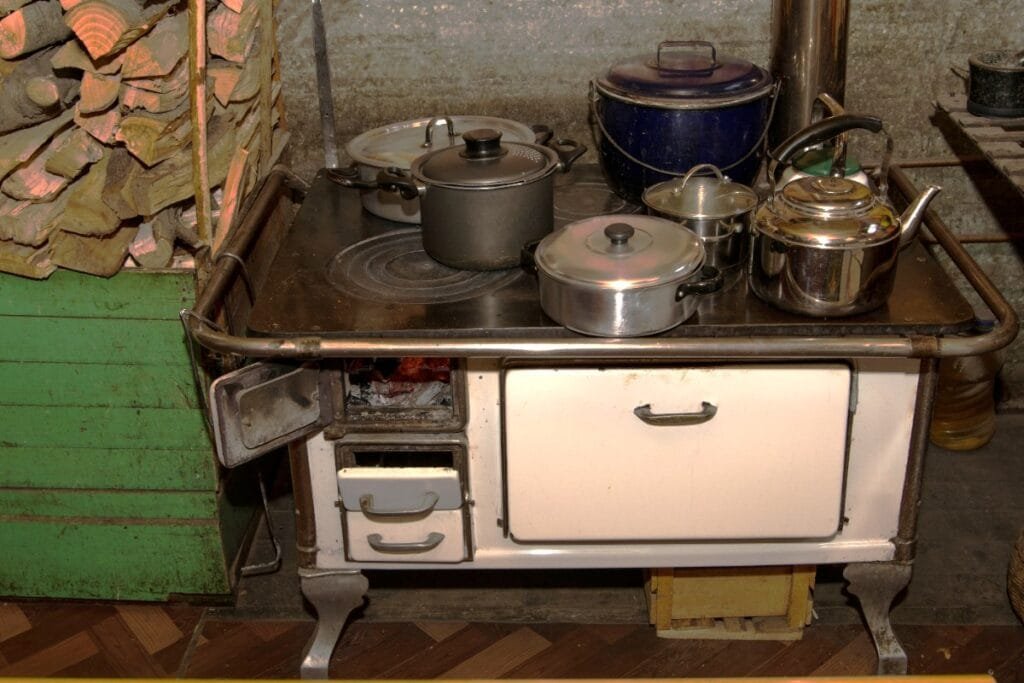
The average value of a vintage oven can range anywhere from $150 to $2,000+ today, depending on several factors, apart from condition alone.
Here’s a quick breakdown of crucial factors that decide whether or not an old oven is worth the money:
- Age: Although not directly, age impacts the value. Generally, pre-1960s ovens command higher values, with 1940s-1950s examples fetching average prices. Early wood stoves are decently valuable.
- Condition: Clearly, a stove that is well-preserved and in excellent condition will always be worth more. Minimal rust, intact enamel, shiny chrome, original shape (no warping), and original finishes are the key signs of good condition.
- Functionality: Working ovens are always worth more than broken ones. If the burners heat properly, timers work, and lights come on, you’re looking at premium pricing. As for repairing and restoration, collectors prefer models that need simple fixes. Examples needing extensive repairs, especially requiring age-old parts, are red flags.
- Completeness: Having all the original knobs, handles, grates, trays, internal parts (like broiler pans or warming well inserts), and specialty accessories is crucial for a vintage oven. Missing or wrong parts really hurt what it’s worth.
- Documentations: Finding original paperwork is rare and adds major value. Pieces that have original manuals, sales receipts, cookbooks/recipe booklets, and print ads attract collectors’ interest.
- Rarity: Rarer oven models generally fetch higher prices. Being rare means it belongs to a short production run, made from materials that didn’t last, or was an experimental model or prototype. Ensure to research the model to find out how rare or common it is.
- Aesthetics: Ovens from popular design eras like Art Deco or Mid-Century Modern command higher prices. Color also plays a vital part; those 1950s pastels like pink, mint green, or turquoise are worth way more than basic white or cream. Likewise, built-in griddles, fancy clocks, or elaborate chrome further up the price.
6 Examples of Rare & Valuable Vintage Ovens
The following examples will show you how the factors above really impact the value of vintage ovens.
Note: The features and prices of the following items are referenced from completed sales and auctions only.
1. Renfrew Chateau Cast Iron Wood Stove Oven
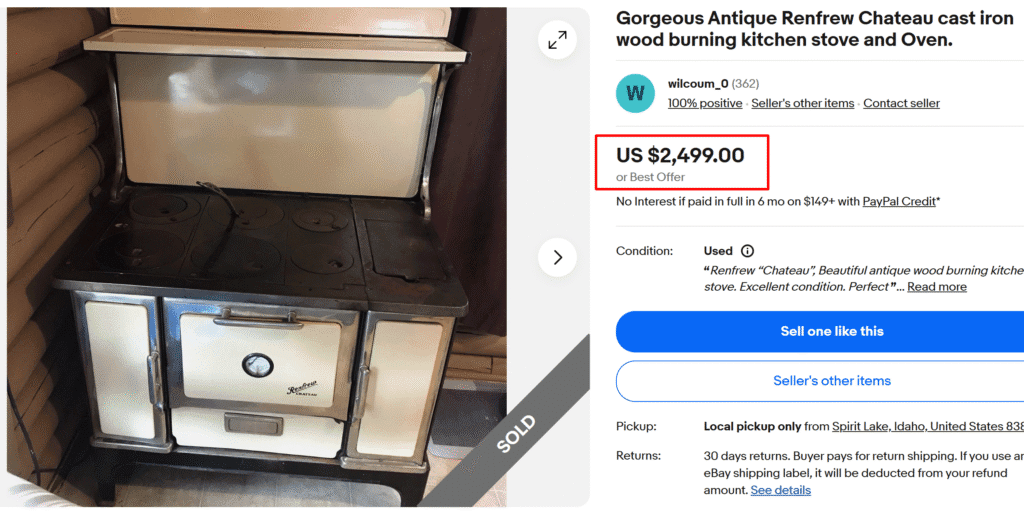
This rare Renfrew “Chateau” model features the classic cast iron construction with cream-colored porcelain panels and black cast iron details. You can see multiple cooking surfaces on top, several ovens and storage compartments, and a warming oven up top.
You’ll also find ornate legs and detailed metalwork in these classic pieces. These massive antique stove ovens are truly rare these days; no wonder this model sold for a mind-boggling price of almost $2,500!
2. Magic Chef Gas Stove Oven
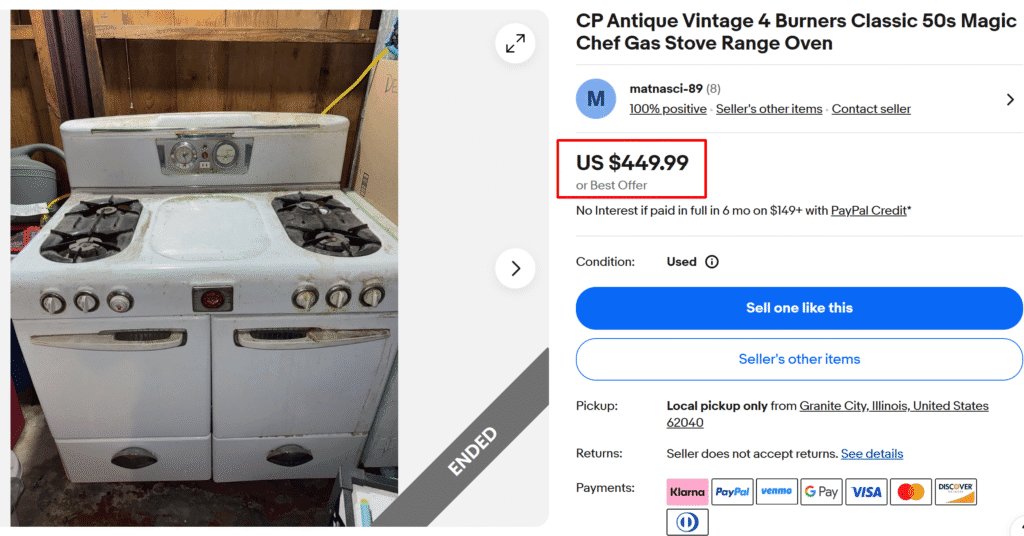
This is a popular white porcelain Magic Chef oven, featuring the common four gas burners with a center griddle area and dual oven compartments below. You can see the classic front-mounted control knobs, chrome handles, and that distinctive Magic Chef control panel layout.
Those dual-door storage or warming compartments below the main cooking surface were a signature feature of these MC ranges. You’ll also find the “Magic Chef” branding on the controller board on top.
Classic MC stove ovens can range from $200 to $800 or more, depending on the condition. This particular example sold for just $450, likely due to the visible wear and tear.
3. O’Keefe & Merritt Gas Stove Oven Broiler
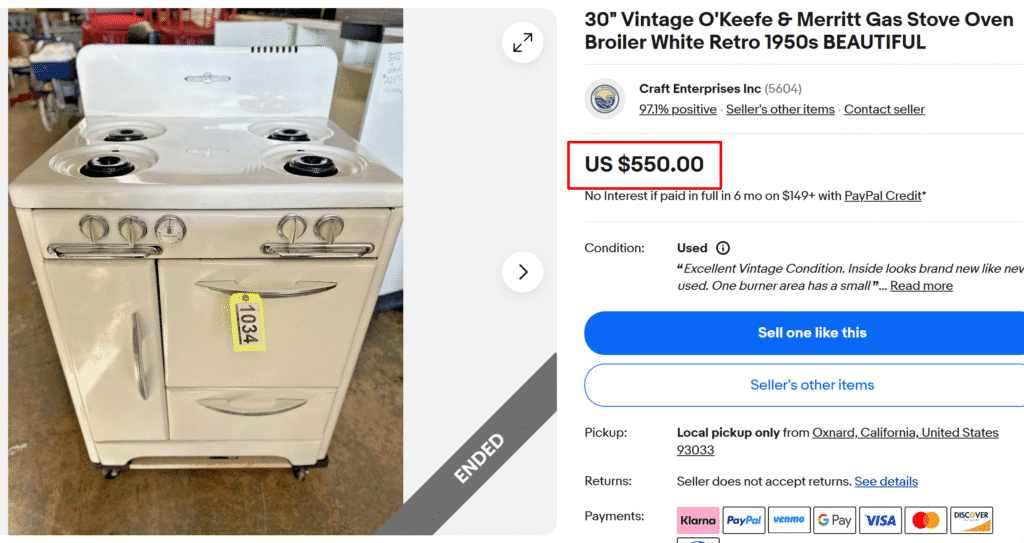
Finding an O’Keefe & Merritt stove oven is a real collector’s dream! It features the classic O’Keefe & Merritt design with four gas burners, chrome drip pans, and those signature fold-down burner covers. You can also spot the chrome handles and trim.
The control knobs are positioned at the front, and you can see the classic oven door design below. Overall, this 30-inch wide oven has everything that made O’Keefe & Merritt famous in California.
4. 1950s General Electric Wall Oven
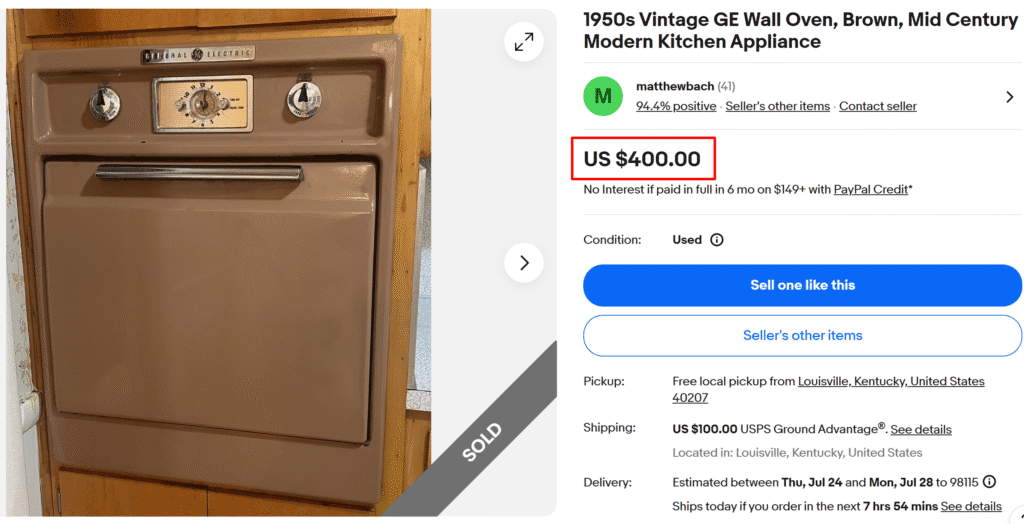
This brown General Electric drop-door wall oven is a perfect example of 1950s kitchen design, when it was all about earthy tones. You can see the classic analog clock and chrome temperature controls that were standard on quality ovens of this era.
GE wall ovens from the 1950s are popular for their solid construction, and many are still in working condition. The company was one of the biggest names in appliances, which is why this piece sold for a stunning price of $400!
5. Hotpoint Electric Wall Oven
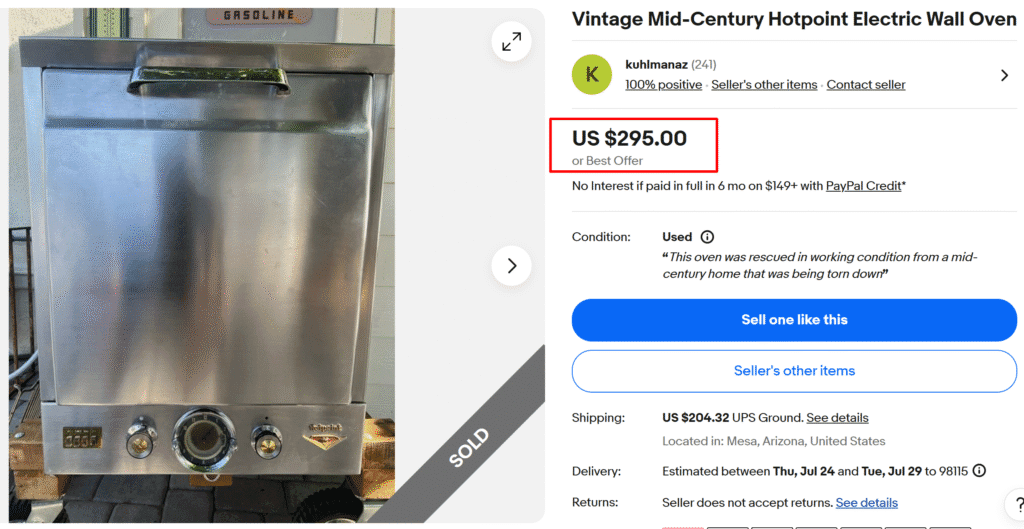
This sleek stainless steel built-in wall oven from Hotpoint is a classic 1950s design with its clean lines and chrome finish. It stands 26 and a half inches tall, making it highly convenient, which is why it was once so popular!
The body is all made of stainless steel with analog controls, switches, a timer, and the “Hotpoint” name and logo on the lower panel. On the inside, you’ll find two grills. This specific model is marked “10RJ1,” a sign of authenticity.
These models can be highly collectible today, since Hotpoint was a big name in the mid-century kitchen appliances world. And, finding a working piece with all pieces and finish intact is rare.
6. General Electric Toaster Oven Broiler
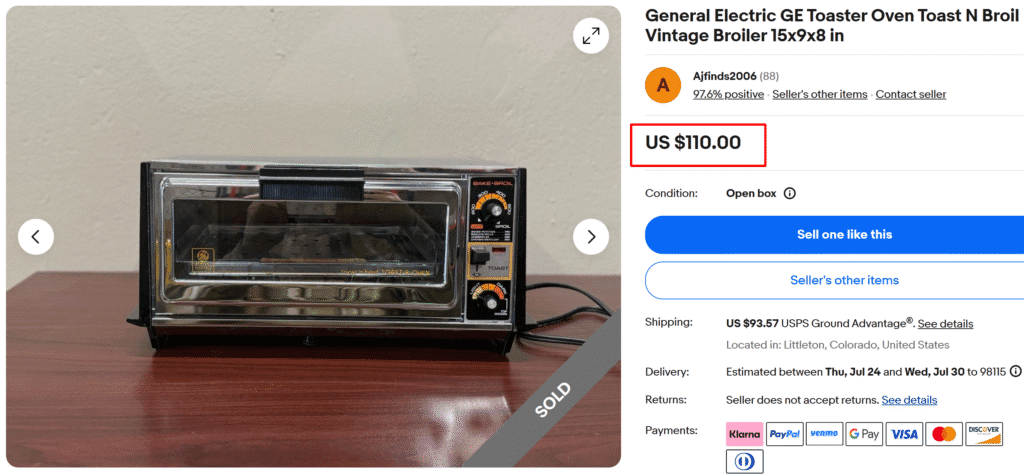
Although not exactly vintage, General Electric countertop ovens are also quite collectible. It’s a chrome and black “Toast N Broil” oven with the classic late 1970s to early 1980s design – distinctive control panel featuring orange and brown accent colors and dual rotary controls!
The oven features temperature settings up to 500°F for baking, controlled by the top knob. The bottom knob controls toast darkness from light to dark. The large glass door is a defining feature of late 20th-century craftsmanship.
GE’s Toast N Broil ovens were the standard for countertop cooking, making them valuable to date. In good and working condition, these can fetch $100 to $400+!
Note: This article is intended for informational, educational, and entertainment purposes only. Some images are illustrative and may not represent actual brands, products, or related entities. All trademarks, product names, brand logos, packaging, and other intellectual property referenced remain the exclusive property of their respective owners. Any brand mentions or references are provided solely for descriptive and educational context and do not imply any formal or commercial association.

